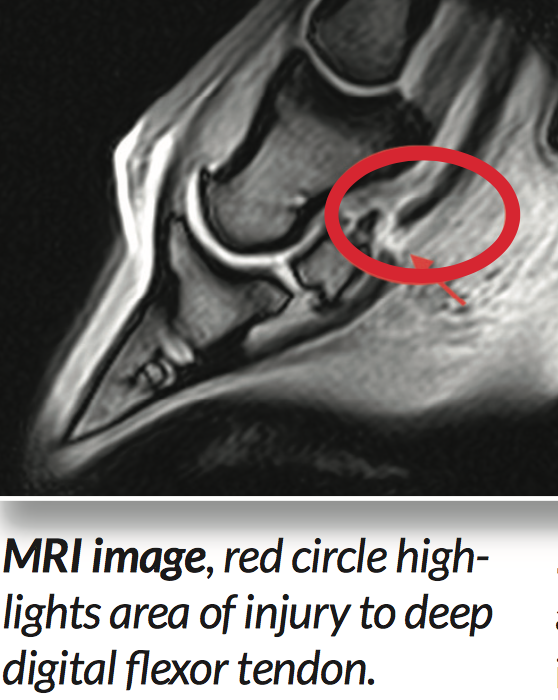 by Maureen Kelleher DVM, DACVS, Clinical Assistant Professor of Sports Medicine
by Maureen Kelleher DVM, DACVS, Clinical Assistant Professor of Sports Medicine
Navicular Disease has long described lameness attributed to the navicular bone region and often resulted in career-ending lameness. Until recently, tools traditionally used to diagnosis navicular such as digital radiographs and ultrasound have fallen short on early detection. Today, the gold standard for diagnosis of navicular disease is magnetic resonance imaging (MRI). MRI allows an early and exact diagnosis, which is important to determining the best treatment options needed to achieve positive outcomes. MRI and early detection of navicular disease have afforded many horses the treatment options that can significantly extend their careers.
 The navicular bone region encompasses a variety of structures. The deep digital flexor tendon (DDFT) passes over the navicular bone just before attaching to the under- side of the coffin bone. Between the navicular bone and DDFT is a pouch-like structure called the navicular bursa, which aids in smooth gliding of the DDFT over the navicular bone. The navicular bone also has small associated structures – ligaments holding the bone in place. Injury to these smaller ligaments, such as the impar ligament, could contribute to lameness. A single structure, or a complex of structures, can be injured to create lameness. MRI can precisely detect these injuries.
The navicular bone region encompasses a variety of structures. The deep digital flexor tendon (DDFT) passes over the navicular bone just before attaching to the under- side of the coffin bone. Between the navicular bone and DDFT is a pouch-like structure called the navicular bursa, which aids in smooth gliding of the DDFT over the navicular bone. The navicular bone also has small associated structures – ligaments holding the bone in place. Injury to these smaller ligaments, such as the impar ligament, could contribute to lameness. A single structure, or a complex of structures, can be injured to create lameness. MRI can precisely detect these injuries.
At the Equine Medical Center, standing MRI pro- vides detailed three-dimensional scans of the navicular region, resulting in multiple images to focus on both bone and soft tissue anatomy. Using these images, our veterinarians diagnose the specific anatomic structure(s) causing lameness and the degree of injury. These images prescribe the best treatment options including joint or bursal injections, guided intralesional injections, surgery, therapeutic shoeing, and rehabilitation.
For early detection of navicular disease, contact Kathy Ashland at (703) 771-6800.
(sponsored content; originally appeared in the September 2017 issue of The Equiery)

The Marion duPont Scott Equine Medical Center (EMC) is a premier, full-service equine health facility conveniently located at Morven Park in Leesburg, Virginia. As an integral part of the Virginia-Maryland College of Veterinary Medicine and Virginia Tech, the EMC offers an array of cutting-edge diagnostic and therapeutic technologies and veterinary expertise to provide innovative and cost-effective care for your horse. The EMC offers a broad range of general and advanced specialty services by appointment as well as comprehensive 24/7 emergency services. State of the art technology with cutting-edge expertise…
Serving you, your vet and your horse. Ask your vet about us, or visit us yourself!
703-771-6800 • www.vetmed.vt.edu/emc/
You’re Invited: Sign up (name and email address to emcinfo@vt.edu) for EMC’s free equine health alerts and notice of Tuesday Talks, a free, educational seminar series on topics of interest to the horse community. Like us on Facebook to stay informed about the latest advances in equine medicine and health.












